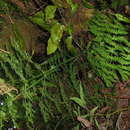en
names in breadcrumbs


Histiopteris incisa, the bat's wing fern, water fern or fern mata, is a common plant found in Australia, New Zealand and other islands in the south Pacific region. Usually found in moist areas, where it may form large colonies. The lowermost lobes of each pinnae have a bat wing like appearance, giving the fern its common name.
Histiopteris incisa is a medium-sized fern, usually producing fronds of approximately 60–200 cm in length. Fronds are widely spaced, distinct, and slightly dimorphic with fertile lobes slightly narrower than the infertile lobes. Fertile lobes have the sori continuous, linear and exindusiate (without an indusium) but protected by reflexed leaf margins.[1] Young fronds have a thick and whitish blue-green succulent stipe. Mature fronds are thin, long with red-brown stipes. Pinnae are pale greyish-green, almost a glaucous colour, they are paired and opposite and set at a wide angle and very lobed. The two lowermost lobes of each pinnae result in a bat's wing like appearance giving the fern its common name.[2] This species has a robust creeping rhizome of 5-10mm width and is covered in brown or reddish scales.[3]
The bat's wing fern is widely distributed and abundant across most of the southern hemisphere including Tasmania. However, it is less common in exposed highland situations and mostly absent from low rainfall regions.[4]
This fern is a ‘weedy’ opportunistic species, freely colonising disturbed sites on the margins of, or within, wet forest,[4] and often forming extensive colonies. It mainly inhabits high rainfall forests with poorly drained soils. Found mainly in shaded areas as shade is necessary for pinnae survival although it can grow in less shaded areas with sufficient water availability. Bat's wing fern is commonly found growing on the margins of wet forests, along more open scrubby creeks and gullies and at the base of cliffs.[2] In rare situations with optimal growing conditions, the fronds can reach lengths of 7m [5]
The bat's wing fern is found in many Tasmanian nurseries and is popular as both an indoor or outdoor plant, as it requires little sunlight and is very aesthetically pleasing. It is a popular pot plant, easily grown in a pot or open ground and is fast spreading in cool, moist environments.[1]
Histiopteris incisa, the bat's wing fern, water fern or fern mata, is a common plant found in Australia, New Zealand and other islands in the south Pacific region. Usually found in moist areas, where it may form large colonies. The lowermost lobes of each pinnae have a bat wing like appearance, giving the fern its common name.
Histiopteris incisa, est une plante commune que l'on trouve en Australie, en Nouvelle-Zélande et dans d'autres îles de la région du Pacifique sud. On la trouve généralement dans les zones humides, où elle peut former de grandes colonies.
La fougère est largement distribuée et abondante dans la majeure partie de l'hémisphère sud, y compris en Tasmanie. Cependant, elle est moins commune dans les situations exposées des hauts plateaux et surtout absente des régions à faible pluviosité[1].
Histiopteris incisa, est une plante commune que l'on trouve en Australie, en Nouvelle-Zélande et dans d'autres îles de la région du Pacifique sud. On la trouve généralement dans les zones humides, où elle peut former de grandes colonies.
Histiopteris incisa là một loài thực vật có mạch trong họ Dennstaedtiaceae. Loài này được (Thunb.) J. Sm. miêu tả khoa học đầu tiên năm 1875.[1]
Histiopteris incisa là một loài thực vật có mạch trong họ Dennstaedtiaceae. Loài này được (Thunb.) J. Sm. miêu tả khoa học đầu tiên năm 1875.
栗蕨(学名:Histiopteris incisa)为凤尾蕨科栗蕨属下的一个种。
|access-date=中的日期值 (帮助)

ユノミネシダ(Histiopteris incisa, 湯ノ峰羊歯)は、1875年に記載されたコバノイシカグマ科のシダである[2]。
常緑性の多年生草本[3]。根茎は長く伸びて横に這う。根茎は太くて径1cmを越え、暗紫色で光沢があり、幅の狭い鱗片がある。葉は間を置いて出て、葉柄も太いものでは径1.5cmを越えるものがあり、基部から脇外芽を伸ばす。葉の先端での成長が止まらないのでどんどん伸びて大きくなり、日本では2m程度であるが、熱帯域では蔓状に伸びて10mに達する例がある[4]。葉全体としては2回羽状から時に4回羽状になる。羽片、小羽片は対生し、羽片の基部の最下1対の小羽片は柄のない托葉状となる。羽片は長さ70cm、幅30cmに達し、小羽片は長さ20cm、幅7cmにもなる。葉質は草質で表面は鮮緑色、裏面は灰緑色となり、縁は裏面に巻く。裂片の形は様々。胞子嚢群は裂片の縁に沿って長く伸び、途切れないことが多い。
ユノミネシダ属には、ユノミネシダ(H. incisa)の1種のみが認められているが、他にいくつかが「未分類」として記載されている[5][6]。ユノミネシダの英名は、"Batwing fern"である[7]。
アジア、オーストラリア、アフリカ、南アメリカ、また様々な大洋島の熱帯から亜熱帯地域に分布する[8][9][10][11][12]。
日本では鉱山跡や温泉地に特異的に出現する[13]。 1887年に和歌山県の湯の峰温泉で発見されたが、この地は分布域の北限に当たり、この自生地は1920年に天然記念物に指定されている[14]。